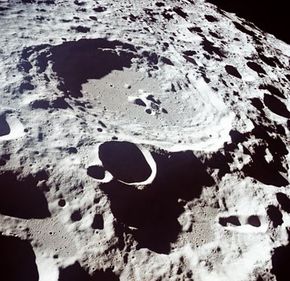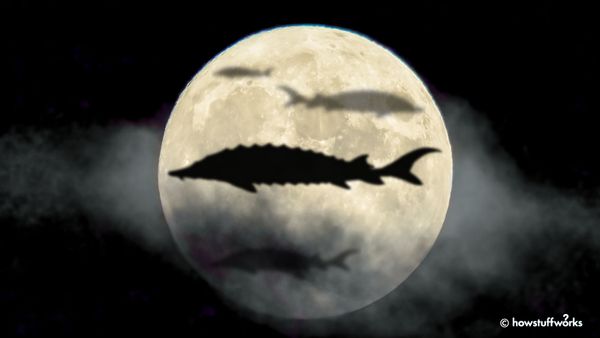What's On the Surface of the Moon?
As we mentioned, the first thing that you'll notice when you look at the moon's surface are the dark and light areas. The dark areas are called maria. There are several prominent maria.
- Mare Tranquilitatis (Sea of Tranquility): where the first astronauts landed
- Mare Imbrium (Sea of Showers): the largest mare (700 miles or 1100 kilometers in diameter)
- Mare Serenitatis (Sea of Serenity)
- Mare Nubium (Sea of Clouds)
- Mare Nectaris (Sea of Nectar)
- Oceanus Procellarum (Ocean of Storms)
The maria cover only 15 percent of the lunar surface.
Advertisement
The remainder of the lunar surface consists of the bright highlands, or terrae. Highlands are rough, mountainous, heavily cratered regions. The Apollo astronauts observed that the highlands are generally about 4 to 5 km (2.5 to 3 miles) above the average lunar surface elevation, while the maria are low-lying plains about 2 to 3 km (1.2 to 1.8 miles) below average elevation. These results were confirmed in the 1990s, when the orbiting Clementine probe extensively mapped the lunar surface.
The moon is littered with craters, which are formed when meteors hit its surface. They may have central peaks and terraced walls, and material from the impact (ejecta) can be thrown from the crater, forming rays that emanate from it. Craters come in many sizes, and you'll see that the highlands are more densely cratered than the maria.
Another type of impact structure is a multi-ringed basin. These structures were caused by huge impacts that sent shockwaves outward and pushed up mountain ranges. The Orientale Basin is an example of a multi-ringed basin.
Besides craters, geologists have noticed cinder cone volcanoes, rilles (channel-like depressions, probably from lava), lava tubes and old lava flows, which indicate that the moon was volcanically active at some point.
The moon has no true soil because it has no living matter in it. Instead, the "soil" is called regolith. Astronauts noted that the regolith was a fine powder of rock fragments and volcanic glass particles interspersed with larger rocks.
Upon examining the rocks brought back from the lunar surface, geologists found the following characteristics:
- The maria consisted primarily of basalt, an igneous rock derived from cooled lava.
- The highland regions include mostly igneous rocks called anorthosite and breccia
- If you compare the relative ages of the rocks, the highland areas are much older than the maria. (4 to 4.3 billion years old versus 3.1 to 3.8 billion years old).
- The lunar rocks have very little water and volatile compounds in them (as if they've been baked) and resemble those found in the Earth's mantle.
- The oxygen isotopes in moon rocks and the Earth are similar, which indicates that the moon and the Earth formed at about the same distance from the sun.
- The density of the moon (3.3 g/cm3) is less than that of the Earth (5.5 g/cm3), which indicates that it doesn't have a substantial iron core.
Astronauts placed other scientific packages on the moon to collect data:
- Seismometers didn't detect any moonquakes or other indications of plate tectonic activity (movements in the moon's crust)
- Magnetometers in orbiting spacecraft and probes didn't detect a significant magnetic field around the moon, which indicates that the moon doesn't have a substantial iron core or molten iron core like the Earth does.
Let's look at what all of this information tells us about the formation of the moon.



